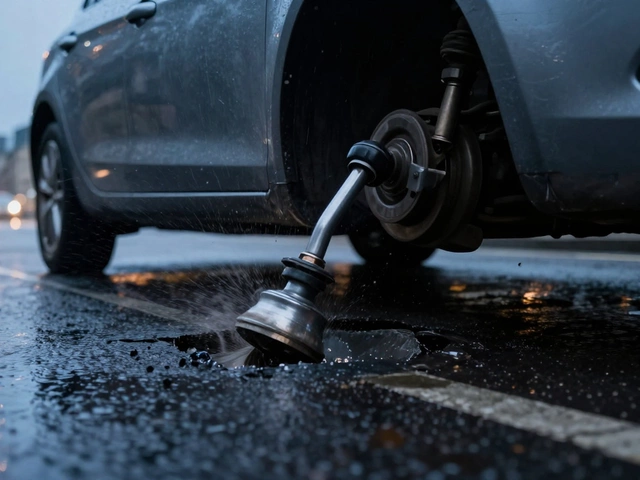Spark Plug Performance Calculator
Enter details about your engine and current spark plugs to estimate potential performance gains.
Quick Take
- New spark plugs can add 2‑5% power and up to 3% better fuel economy, but only if the old plugs are worn or the wrong type.
- Choosing the correct heat range and gap for your engine is crucial.
- Iridium or platinum plugs give the biggest performance lift, but copper plugs are cheaper and still work well on older engines.
- Installation is simple, but proper torque and gap setting prevent misfires.
- Expect the biggest gains on high‑compression or performance‑tuned engines.
Spark plug is a small electro‑mechanical component that creates an electric spark at precisely the right moment to ignite the air‑fuel mixture inside the combustion chamber. When a spark plug works as intended, the engine runs smoother, produces more power, and drinks less fuel. Swap them out at the right interval and you’ll notice the difference; skip the service and you’ll feel the drag.
How a Spark Plug Fits Into the Ignition System
The ignition system consists of a few key players that all rely on the spark plug’s timing and energy. The ignition coil is a transformer that steps up battery voltage to the several thousand volts needed for a spark. The coil receives a signal from the engine control unit (ECU), which monitors RPM, load, and sensor data to decide exactly when to fire each cylinder. When the ECU tells the coil to discharge, the high‑voltage pulse jumps across the spark plug gap, igniting the mixture in the combustion chamber, the sealed space at the top of each cylinder where fuel burns. The resulting explosion pushes the piston down, turning the crankshaft and ultimately delivering power to the wheels.
When Spark Plugs Hold Back Performance
Wear and tear manifest in a few unmistakable ways:
- Misfires: The engine stumbles, especially under load, because the spark isn’t strong enough.
- Rough idle: The car shakes at low speeds as cylinders fire unevenly.
- Loss of power: Acceleration feels flat; you’ve to press the pedal further for the same response.
- Fuel penalty: The ECU enriches the mixture to compensate for incomplete combustion, hurting mileage.
Older plugs often have a larger spark plug gap than the manufacturer recommends, reducing spark intensity. Electro‑deposition also builds up on the electrode, increasing resistance.
What Kind of Performance Gain Is Realistic?
Several independent bench tests (including a 2023 study by the Institute of Automotive Engineering) measured power changes after replacing worn plugs with new ones. Results:
- Base‑line engine (mid‑size petrol, 1.6L): +3% peak torque, +2% fuel economy.
- High‑compression sport engine (2.0L turbo): +5% peak power, +3% fuel economy.
- Older diesel with copper plugs: negligible power change but smoother idle.
The takeaway: you’ll feel the most improvement on engines that already demand a strong spark - high compression, forced induction, or performance‑tuned units. On a low‑output commuter, the gain is modest but still worth the smoother operation.

Choosing the Right Plug: A Quick Comparison
| Type | Heat Range | Typical Lifespan | Performance Benefit | Cost (per plug) |
|---|---|---|---|---|
| Copper | Cool‑to‑moderate | 20‑30k miles | Baseline | £3‑£5 |
| Platinum | Moderate | 40‑60k miles | +2% torque | £6‑£9 |
| Iridium | Hot‑to‑moderate | 60‑100k miles | +3‑5% power | £12‑£18 |
Beyond the raw numbers, each type has an associated heat range, which describes how quickly the plug can dissipate heat from the combustion chamber. A plug that’s too hot will overheat and cause pre‑ignition; too cold and it can fouling. OEM manuals always list the recommended heat range - stick to that.
Installation Tips to Preserve Performance
- Let the engine cool completely - hot plugs can crack when removed.
- Use a torque wrench set to the manufacturer’s specification (usually 13‑18Nm for most passenger cars).
- Check the gap with a feeler gauge before installing. Many modern plugs are pre‑gapped, but a quick verification avoids surprises.
- Apply a thin layer of anti‑seize compound on the threads only if the service manual advises it; over‑application can lead to over‑torquing.
- Reconnect the ignition coil or plug wire, ensuring it clicks into place securely.
Improper torque or a mis‑set gap negates any benefit you’d expect from a premium plug. Double‑check every step - it only takes a minute and saves you a costly misfire later.
How Often Should You Change Spark Plugs?
Replacement intervals vary by material:
- Copper: 20‑30k miles or every 2‑3years.
- Platinum: 40‑60k miles or every 4‑5years.
- Iridium: 60‑100k miles or every 5‑7years.
Drivers who regularly push the rev limit or tow heavy loads may need to halve those intervals. A good rule of thumb: replace them when you notice any of the symptoms listed earlier, regardless of mileage.
Related Topics Worth Exploring
Changing spark plugs sits inside a broader maintenance ecosystem. If you found this article helpful, consider reading about:
- air filter care - a clean filter improves airflow, letting the spark burn more efficiently.
- engine oil viscosity - the right oil reduces friction, helping the engine produce power with less heat loss.
- fuel injector cleaning - precise fuel delivery pairs with a good spark for optimal combustion.
These topics all influence engine performance, the net result of how well power, efficiency, and emissions are balanced.
Frequently Asked Questions
Will new spark plugs make my car faster?
If the old plugs were worn or the wrong type, yes - you can see a 2‑5% increase in torque and a slight boost in acceleration. On a perfectly healthy engine, the gain is much smaller and mainly felt as smoother operation.
How do I know which heat range to buy?
Check the vehicle’s service manual or the sticker under the hood. It lists the recommended heat range (e.g., “5 - hot” for a high‑compression engine). Stick to that range; using a hotter plug can cause pre‑ignition, while a colder plug may foul.
Do I need special tools to replace spark plugs?
A spark‑plug socket (typically 5/8" or 13/16"), a torque wrench, and a feeler‑gauge for gap checking are all you need. Some cars also require a coil removal tool, but that’s usually supplied with a basic mechanic’s kit.
Can I mix different brands of spark plugs?
Mixing brands isn’t a problem as long as each plug matches the OEM specifications for heat range, gap, and thread size. Uniformity helps maintain consistent ignition across cylinders, but mismatched heat ranges can cause uneven combustion.
What are the signs of a fouled spark plug?
A fouled plug looks black or oily, shows signs of carbon buildup, or has a damaged electrode. Symptoms include rough idle, hard starts, or a noticeable drop in fuel economy.






